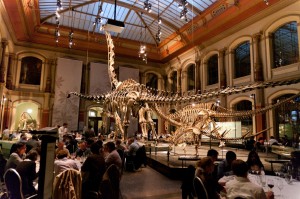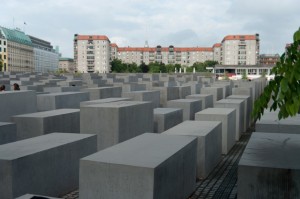One of the nice perks of doing a PhD is visiting conferences. It is a nice way to meet colleagues, present and discuss results and, let’s be honest, to see other places. Two years ago I went to a conference in the US and I stayed a bit longer to visit a friend who was living in Berkeley (near San Francisco) at the time. This year I went to a conference in Berlin – not as “exotic” as the US, but I never visited Berlin before, so I was still curious to see it.
Just to get it out of the way, I went to the “Coherent Multi-Dimensional Spectroscopy”-conference. It is a more specialized conference, with about 130 participants. The conference was well-organized and I really enjoyed it.
Part of the conference was the dinner in the “Naturkunde Museum” – Museum for Natural History. We had a tour along some highlights, which included animals in (m)ethanol (not very appetizing) and some extinct and/or ancient animals, like the predecesor to the zebra and the elephant. It was a pity we had to hurry a bit because we had to be on time for the dinner – in the entrance hall, next to/underneath some dinosaurs. Yep, we had dinner underneath some fricking dinosaurs. Pretty cool.
After the conference was finished on Wednesday afternoon we went to see the city. We started the tour at the Potsdammer Platz, which was a no-man’s-land during the Cold War. There are still five old pieces of the Wall, but it is now surrounded by massive shiny new buildings. I guess it is nice when you like modern architecture.
Then we went into the direction of the Brandenburger Tor, passing the Holocaust Memorial. It is a lot of concrete blocks. First I was a bit disappointed: “just some concrete blocks?”, but what kind of memorial can represent something of such unimaginable proportions? Maybe it is better to keep the memorial “simple” and keep the story alive. The individual tales of the Second World War are visible all around Berlin. There are signs on buildings where notable people were murdered, there are small gold stones in the ground to commemorate people who died in concentration camps.
After the Brandenburger Tor and the Reichstag (not much to say about it, really), we ended up at the Siegesäule, a pillar with a gold statue on top. It is in the middle of a roundabout. I was a bit surprised by the amount of traffic in the tourist areas. The street between the Siegesäule and the TV-tower (with the Brandenburger Tor in the middle) is both very touristy and a major traffic artery. I didn’t really like that part.
It was nice to do this walk after three days of conference. We ended the day with a dinner in some restaurant in a less touristy area. By the way: with “we” I mean me and an American PhD student who also stayed a bit longer to visit Berlin.
On Thursday we visited the Berliner Dom – a large church. Then we went on to the DDR-museum. It is a very hands-on museum and gives an insight into life in East Germany. It does a great job, but it doesn’t really show how people elsewhere lived. It makes it hard to judge if something is old-fashioned or DDR-fashioned. They have a Trabant, a small and simple car. But the old Mini was also small and simple, right? Still, it is a nice museum that shows how life actually was – not how you can interpret it.
With that my stay in Berlin was basically finished. Berlin is a nice city and I had a good time there. Now back to the lab for the last half year of my PhD.
—
More photos can be found here.

